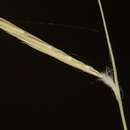Comprehensive Description
provided by North American Flora
Bouteloua eriopoda (Torr.) Torr. Pacif. R. R. Rep. 4: 155. 1857
Chondrosium eriopodum Torr. in Emory, Notes Mil. Rcc. 154. 1848.
Bouteloua brevifolia Buckl. Proc. Acad. Phila. 1862: 93. 1862. (Type from western Texas, Wright 748.)
Perennial; culms wiry, straggling, sparsely stoloniferous, geniculate at the nodes, feltypubescent, the base rather hard and knotty; upper sheaths shorter than the internodes, glabrous, the lov.ermost crowded, felty-pubescent; blades flat or loosely rolled, attenuate, mostly 5-10 cm. long, 1-2 mm. wide, glabrous; spikes 3-5, mostly 2-5 cm. long, somewhat curved, ascending or sometinies spreading; spikelets rather loosely arranged, nearly appressed to the rachis; glumes acuminate, the first narrow, 3 mm. long, the second broader, 7 mm. long, glabrous; lemma 6-7 mm. long, bearded at the base, sparsely pilose on the margins and midnerve, acuminate, gradually narrowed into the awn, the awn 3-4 mm. long, the lateral awns very short; rudiment short-bearded at the top of the slender rachilla-joint, almost reduced to 3 slender scabrous awns about 7 mm. long.
Type locality : New Mexico (Bigelow) .
Distribution: Mesas, hills and dry open ground, Utah, western Texas, New Mexico, Arizona, and northern Mexico.
- bibliographic citation
- Albert Spear Hitchcock, Jason Richard Swallen, Agnes Chase. 1939. (POALES); POACEAE (pars). North American flora. vol 17(8). New York Botanical Garden, New York, NY
Physical Description
provided by USDA PLANTS text
Perennials, Terrestrial, not aquatic, Rhizomes present, Rhizome short and compact, stems close, Stolons or runners present, Stems nodes swollen or brittle, Stems geniculate, decumbent, or lax, sometimes rooting at nodes, Stems terete, round in cross section, or polygonal, Plants conspicuously hairy, grayish, or wooly, Stem internodes hollow, Stems with inflorescence less than 1 m tall, Stems, culms, or scapes exceeding basal leaves, Leaves mostly basal, below middle of stem, Leaves conspicuously 2-ranked, distichous, Leaves sheathing at base, Leaf sheath mostly open, or loose, Leaf sheath smooth, glabrous, Leaf sheath hairy at summit, throat, or collar, Leaf sheath and blade differentiated, Leaf blades linear, Leaf blad es very narrow or filiform, less than 2 mm wide, Leaf blades mostly flat, Leaf blade margins folded, involute, or conduplicate, Leaf blades mostly glabrous, Leaf blades scabrous, roughened, or wrinkled, Ligule present, Ligule a fringe of hairs, Inflorescence terminal, Inflorescence with 2 or more spikes, fascicles, glomerules, heads, or clusters per culm, Inflorescence a panicle with narrowly racemose or spicate branches, Inflorescence with 2-10 branches, Inflorescence branches 1-sided, Inflorescence branches terminating in bristle or point, Flowers bisexual, Spikelets sessile or subsessile, Spikelets laterally compressed, Spikelet less than 3 mm wide, Spikelets with 1 fertile floret, Spikelets solitary at rachis nodes, Spikelets all alike and fertille, Spikelets bisexual, Spikelets disarticulating above the glumes, glumes persistent, Spikelets secund, in rows on one side of rachis, Rachilla or pedicel glabrous, Glumes present, empty bracts, Glumes 2 clearly present, Glumes distinctly unequal, Glumes equal to or longer than adjacent lemma, Glume equal to or longer than spikelet, Glumes 1 nerved, Lemma coriaceous, firmer or thicker in texture than the glumes, Lemma 3 nerved, Lemma glabrous, Lemma body or surface hairy, Lemma apex acute or acuminate, Lemma mucronate, very shortly beaked or awned, less than 1-2 mm, Lemma distinctly awned, more than 2-3 mm, Lemma with 1 awn, Lemma awn less than 1 cm long, Lemma margins thin, lying flat, Lemma straight, Palea present, well developed, Palea membranous, hyaline, Palea shorter than lemma, Palea 2 nerved or 2 keeled, Stamens 3, Styles 2-fid, deeply 2-branched, Stigmas 2, Fruit - caryopsis, Caryopsis ellipsoid, longitudinally grooved, hilum long-linear.
Bouteloua eriopoda: Brief Summary
provided by wikipedia EN
Bouteloua eriopoda, commonly known as black grama, is a perennial prairie grass that is native to the Southwestern United States. Its main means of reproduction is by stolons, as its ratio of viable seeds to sterile ones is naturally low. The disparity may play a role in its lack of tolerance to overgrazing (relative to other grasses), but aside from this B. eriopoda is a good forage food for livestock.
It was first described, as Chondrosum eriopodum, in 1848 from specimens collected along and nearby the "Del Norte" river in New Mexico.
- license
- cc-by-sa-3.0
- copyright
- Wikipedia authors and editors

